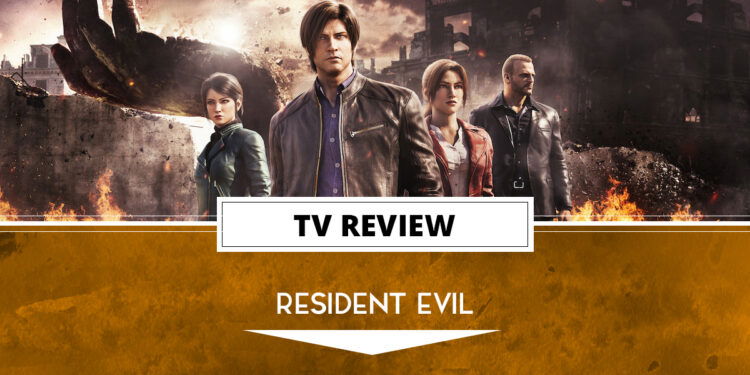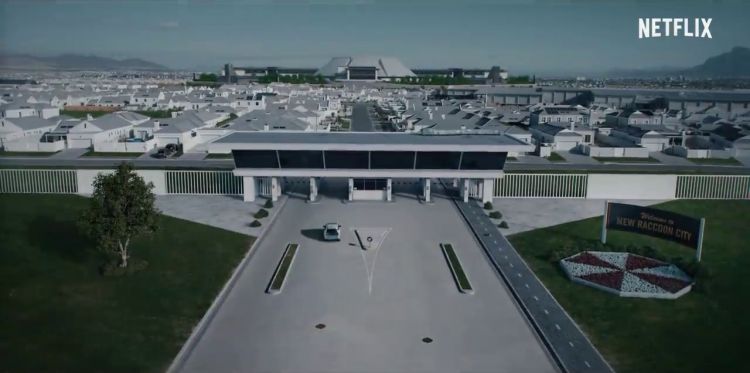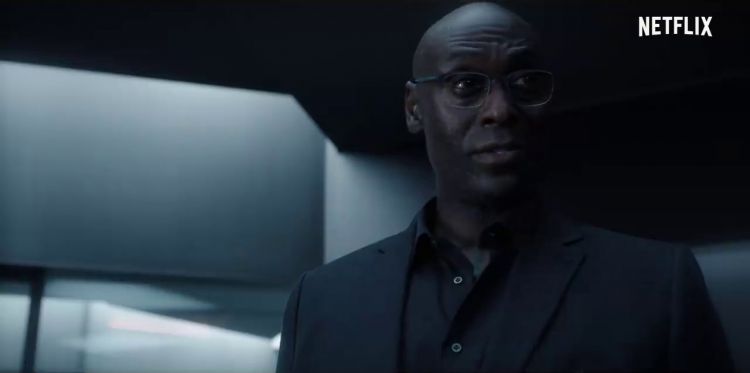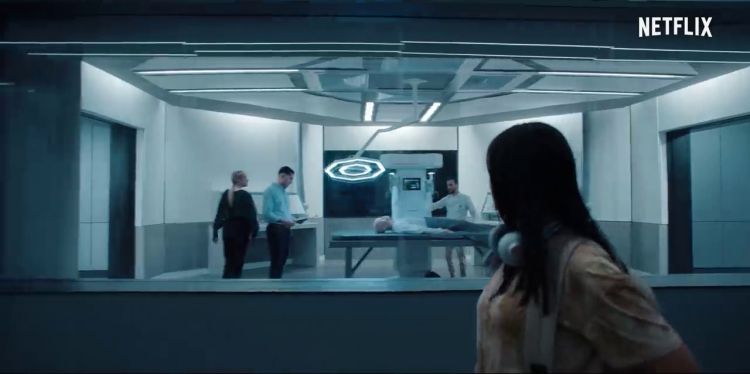Out of all the things I’m known for here at The Outerhaven, it’s Teenage Mutant Ninja Turtles and Resident Evil. So when I heard that Netflix was doing yet another Resident Evil TV series (Netflix already did Resident Evil: Infinite Darkness), I was interested in what could become of my favorite zombie-infested franchise. Like many Resident Evil fans, I was skeptical about the casting and the little bits of the story we found out during production. But now that I’ve seen the finished product, I can say that Netflix’s version of Resident Evil is… something.
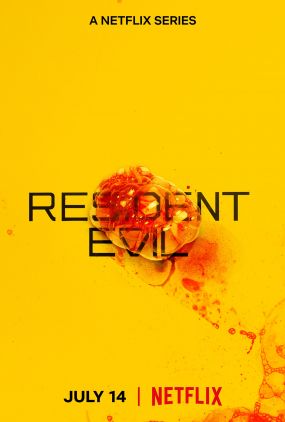
Production Company: Amalgamated Nonsense, Constantin Television, Moonlighting Films
Distributed by: Netflix Streaming Services
Produced by: Andrew Dabb
Starring: Ella Balinska, Tamara Smart, Siena Agudong, Adeline Rudolph, Paola Núñez, & Lance Reddick
Based on: Resident Evil by Capcom
Release dates: Out Now
Running time: 46–63 minutes per episode (8 Episodes)
Welcome to New Raccoon City (Story)
The series’ main plot is spread out over two points in time – 2022 and 2036, with a gap of some 14 years. The “past” plotline deals with the struggles of 14-year-old half-twins Billie and Jade, the children of Dr. Albert Wesker, and conceived through suspicious circumstances. Their lives take a dramatic turn when Albert is awarded an executive position at the struggling Umbrella Corporation that once employed him, and they move to Umbrella’s planned community, New Raccoon City. While there the two girls stumble onto the dark secrets behind their origins and Umbrella’s dark legacy while their father coordinates a response to the outbreak of a retroviral bioweapon called T-virus.
In the “present” of 2036, the T-virus has reduced human civilization to 300 million refugees living in walled city-states and other settlements, surrounded by the six billion “Zeroes” who contracted the disease and became roaming gangs of cannibal mutants. The most powerful organization left on Earth is the Umbrella Corporation, backed by its military arsenal, which is conducting a global manhunt for Jade.
Experiments, clones, robots, or other (Characters)
- Ella Balinska as Jade Wesker
As the older version of the main character, you can see that this version of Jade is more battle-hardened, more of a scientist, and can see the evolution of the T-Virus in terms of making the zombies smarter and more organized. However, where the character drops off is being a mother and trying to humanize the character by giving her something to lose. You can see that this is a Jade who has really been affected by the 2022 events and tried to do better because of them. Yet I feel that when the daughter is introduced that the Jade character really loses connection to what her driving force really is. - Tamara Smart as young Jade Wesker
A bitchy, egotistical, aggressive young person… So pretty much every GenZ teenager these days. She’s upset that she is in a new place because of her father, who she has some sort of grudge against from the beginning, then when the secrets come out, she becomes more justified in her feelings for her father. However, she does have a heart for her sister, and becomes more protective of her as things keep going, but gets sidetracked by hunting down the truth about herself, her sister, and Umbrella that you can see the divide happening over time. Very well acted. - Adeline Rudolph as Billie Wesker
She’s hot… But there’s very little character development with this version of Billie as there is with the younger version. You’d think with what she goes through in the younger days that there would be more that we should learn about her, but nope. We might get something in a second part/season that fixes this issue, but in Resident Evil we get nothing. We only know she is smart, aggressive, without mercy, and thinks she is the evolution of humankind… That’s it.
- Siena Agudong as young Billie Wesker
Much like the older version, we don’t get much development from this version of Billie. While she is the reason things end up the way they were in the “present” timeline, as a teenager, she just mopes around, gets bullied, and then goes nuts when she is infected. She really needed more development as a character so we understand what happens to her to become the older version, at least more than using the T-Virus as the reason. But nope, lazy writing. - Paola Núñez as Evelyn Marcus
A great villain for the modern age. As the head of Umbrella, Marcus is a name that many would know from the Resident Evil game series. In this version, Marcus is the boss who wants to do everything she can to make Umbrella the highest profitable company on the planet and gives zero fucks about how many people have to die in order to do so, a great example of modern-day companies and their greed for profits. Even when Resident Evil tries to make Marcus a somewhat sympathetic character, they throw it away in order to make her look more ruthless, which works extremely well. A show stealing performance in a show that really needed its villains to stand out. - Lance Reddick as Albert Wesker
How to talk about Albert Wesker in Resident Evil… A real issue because of the spoilers that would be needed in order to explain what happens in Resident Evil. So without spoiling anything, I’m just going to say that Reddick works extremely well in all his roles in Resident Evil. Yes, he has multiple roles here. You really get to see a variety of Reddick’s acting range in this role, and he does a really good role as Albert Wesker I want to see him replace whoever they get to do the voice acting for Wesker in the games from now on. When Reddick is Albert Wester, he does the role justice. Surprisingly good casting with a great actor. - Turlough Convery as Richard Baxter
A special shout-out here. The Baxter character is a new addition to Resident Evil, written just for the show. When first introduced you think he’s going to be a bit of an Umbrella comedy stooge, but then you get to one scene, and he turns into a 100% badass. I was actually annoyed when he bites the big one not too long after this scene. I would have liked to have seen him continue to live and maybe change sides at some point. But nope, the dude gets to be badass, and then he dies. Guess unless your name has Redfield or Kennedy in it you cannot be a badass male in modern Resident Evil stories.
Itchy, tasty (What Worked)
When Resident Evil is trying to be Resident Evil, it works extremely well. While it might be in the form of name drops, the appearance of monsters from the series, and the whole “deep dark secrets” thing that Umbrella and Albert Wesker are known for, it just works. It’s during these moments that my interest got some attention, and I was looking forward to seeing if anything was going to follow through. But in a typical Resident Evil style, you’re left with more questions than answers when you walk away from watching Resident Evil. This makes watching Resident Evil feel more like a test bed to see if the Resident Evil name alone was enough to carry the first part of the series before Netflix decides to put more of a budget out there for another part where we will get more of the Resident Evil that we know already.
One thing that did surprise me with Resident Evil was the casting. Like a lot of other long-time Resident Evil fans, I was a bit worried about the casting of Lance Reddick in the role of Albert Wesker… And yes, it’s because I thought this casting was based around his skin color and the fact we’re still neck-deep into this “progressive for no other reason than to create controversy and score Twitter clout” era. However, watching and hearing Riddick in the role, I walked away from Resident Evil thinking that Reddick did a DAMN good piece of work with the role… When he was acting like Albert Wesker. Hell, I even said to my wife, who was watching with me at the time as a horror nerd (And semi-Resident Evil fan), that Reddick should be the voice of any Albert Wesker that CAPCOM adds into remakes or future Resident Evil titles.
Speaking more about the casting of Resident Evil, just about every role was written well and acted well… For the most part. Everyone in Resident Evil is really good at working with their assigned roles, except Siena Agudong, who seems to get the short end of the character development stick (Except for the fact that she is the main reason for events in Resident Evil to happen) and ends up flipping from good moments to some really cringe acting.
As I mentioned above, a special shout out to Turlough Convery as Baxter, who steals the show in one of the best action scenes in the whole series thus far. Shame he dies not too long afterward.
What are you? A Jill Sandwich (What didn’t work)
I have 2 problems with Resident Evil, one from a narrative/editing standpoint, and the other from a writing standpoint.
Starting with the writing standpoint as it’s a bit easier to explain. Resident Evil did great when it is being Resident Evil, but otherwise, Resident Evil comes off as one of two things: A young adult drama series (The extremely long and boring sisters bonding/helping/surviving aspect) and “Generic Zombie Series #365”. I understand that the main focus of Resident Evil is the two sisters and how their relationship and their connection to Wesker and Umbrella is what the writers are using as a plot connection device, but sometimes the excessive use of the sisters supporting each other really slowed the show to a zombie shuffling crawl. Then there is the Umbrella pushing their new drug “Joy” side of things, which shows how evil the Evelyn Marcus character is, but it comes off as repetitive when you hear about how much she wants to change the world with the drug for the 50th time.
Then there is the other thing that annoyed me about Resident Evil, which was the way the story was told. In Resident Evil, you get two points in time to deal with and two stories to follow along with too. The first is the “past,” where it’s 2022, and we’re learning about Billie, Jade, Wesker, etc, and how another outbreak began with the New Raccoon City. Then you have the “present” where it’s 2036, the world has pretty much been taken over by the T-Virus with zombies (Called “Zeros”) and other infected animals (Giant Catapillers, Crocodiles, and Spiders) and monsters (Lickers), where Jade is researching the zombies in order to find some prevention or cure for the T-Virus while avoiding Umbrella.
The reason I find this annoying is because of the way things are produced. Resident Evil has a “smash cut” style of editing between the two points in time, where you would get invested in one time and settle in with the current Jade or Billie moments only to drop suddenly into the other time point, and continue that story all of a sudden. I know that Resident Evil wanted to tell two stories, but telling them at the same time comes off as confusing and irritating. Resident Evil would have been better off building the “past” section first, building the story and universe over the first season, then working into the “present” storyline down the track once we know and understand what was happening. A big example of this is Billie herself, who is missing for about the first half of the “present” storyline, only to reveal herself before her “past” self disappears. So, you’ve created a mysterious moment in the “present” time point which is spoilt before it begins in the “past” time point.
Then there are issues with things that are introduced in episodes 6 through 8 involving Albert Wesker. While we do get an answer to one of the big timeline questions of Resident Evil (Where in the game’s timeline does this fall. Answer: After Resident Evil 5, somewhere possibly during or after Resident Evil 6, but well before Resident Evil 7) it then raises more question inside Resident Evil itself when it comes to the two time points they are showing. You get a line from Billie talking about Wesker like it was a recent thing in the “present” timeline, but you see something happen in the “past” timeline that contradicts the statement. It’s the two points in time that become too much of an issue that the writers are just hoping that you’ll forget or not notice.
At least it tried (Closing)
As I said before, when Resident Evil is being Resident Evil, it works. However, there are things with the writing, editing, and narrative creation that really drop the excitement of watching the show. There were moments while watching Resident Evil where I’d get excited by a name drop, reference to events, and the Lickers; only to have to explain it to my wife, who was watching as a “casual” knower of the lore. When we finished the series, we said it was something… not too bad, not too good either. Resident Evil needs a second part or season or whatever Netflix does to really see if this show is something that Resident Evil fans could get into. At least it’s better than the Resident Evil movie series, even if it does take some things from that too.
Review Disclosure Statement: Resident Evil was provided to us by Netflix for review purposes. For more information on how we conduct and handle reviews here, please visit our Review Guideline/Scoring Policy for more info. Thank you
Affiliate Link Disclosure: One or more of the links above contain affiliate links, which means at no additional cost to you, we may receive a commission should you click through and purchase the item.
Summary
When Netflix’s Resident Evil actually tries to be Resident Evil, it does it well, with enough references and name drop to give Resident Evil nerds something to look forward to. However, outside of that, Resident Evil comes off as a generic young adult drama combined with generic zombie show cliches. You can tell that Netflix really wanted to see if the Resident Evil name alone could begin to carry a story before real investment would be made with a second part/season… If we get it.
Pros
- When it’s Resident Evil, it works
- Lance Reddick as Albert Wesker
- Practical zombie effects
Cons
- Very obvious CGI on Lickers and rats
- Billie’s lack of character development
- The awkward editing/narrative storytelling


